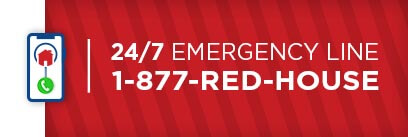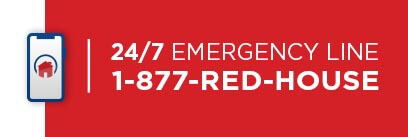
It’s oh so important, yet we don’t often talk about it: homeowners insurance. Your coverage provides such important financial protection against loss due to disasters, accidents, and even theft. It’s definitely worth reviewing.
Most standard policies include four essential types of coverage:
- Coverage for the Structure of Your Home
- Coverage for Personal Belongings
- Liability Protection
- Coverage for Additional Living Expenses (ALE)
According to the most recent study conducted by the Insurance Information Institute, property damage accounted for 98% of insurance claims in 2017.

- Tony Silva, CEO, Home Repair"It’s oh so important, yet we don’t often talk about it: homeowners insurance. Your coverage provides such important financial protection against loss due to disasters, accidents, and even theft. It’s definitely worth reviewing."
Given that high number, we’re going to focus on Coverage for the Structure in this article. If your home is damaged by lightning, hail, hurricane, fire, or other disasters listed in your policy, your homeowners insurance pays to repair or rebuild your home. Your policy should also cover detached structures such as a garage or shed. This coverage is typically about 10% of the total amount of insurance you have on your home structure. It’s very important to note, standard policies typically do not pay for damage caused by a flood, earthquake or routine wear and tear. When purchasing coverage for the structure of your home, remember this simple guideline: Purchase enough coverage to rebuild your home. Get supplemental policies where applicable.
A Property Claims Satisfaction Study by J.D. Power found that overall customer satisfaction among homeowners filing property insurance claims reached a new all-time high, despite record-high property losses. The study found that insurers achieved high levels of customer satisfaction when they were effective at managing customer expectations regarding the time length to settle claims.
By choosing the best policy, you can save tens of thousands of dollars by reading through the small print and making sure you have appropriate coverage. This can be confusing, but remember, knowledge is power! Check out five important aspects of your policy to review below that could save you tens of thousands of dollars, and lots of time.
1. Deductibles
Check your deductibles to make sure you can afford that amount of out-of-pocket if you get hit! Sometimes the deductible/co-pay can be up to 5% of your home’s value. This number can get quite high! Imagine if your $250,000 home had a tree fall on it, and the bill to remove the tree, fix the roof and interior damage equals $25,000. If you have a 5% deductible or co-pay, this means you have to pay $12,500 to get that taken care of because that’s your “deductible” in this scenario.
Often, the details are in the fine print and it may have only saved you $5/month to have the higher deductible. Often, a more reasonable deductible of $500 or $1,000 only costs pennies more per day, or even the same amount, depending on the insurance company. This deductible is worth it… 100X over.
2. Building Code Coverage
Check with your agent to ensure that you have building code coverage. It’s a sneaky one that can cost you thousands of dollars if you don’t have it. This also only costs pennies more per day. If your home is damaged or destroyed from a storm or even a fire, it will have to be replaced back to current codes if you’re working with a quality, licensed general contractor (that is unwilling to break the law.) If you don’t have this in your policy, it could cost you tens of thousands of dollars, especially if your home is more than 10 years old. Most “good” insurance carriers out there include this in their policies, but many have gotten crafty and excluded it. We’re not going to name names here, but you may be surprised to find out that some of the larger, well-known companies are on that list. You may find that you’re not in good hands in regards to building code coverage. Be sure to find out.
3. Replacement Cost Value
Check to make sure you have full Replacement Cost Value coverage on ALL of your property. Many times the “crafty” insurance companies only give you a reduced value based on the age of your homesite. It’s called ACV, or sometimes “shared value”. Either way, you want to make sure that if it’s damaged or destroyed you will get the full value of what it costs to repair or replace it. Just ask your agent if you have full replacement cost value coverage on everything, and be sure to get their response in writing. This is another “sneaky” trick that some carriers use to “save you money”, when in reality, its standard with most carriers, usually for the same price.
4. Cosmetic Endorsements
This one is a relatively new trick in the book that we are seeing more of. Sometimes the “crafty carriers” have a “cosmetic exclusion” in the policy that essentially says, they will not pay to repair something that was extremely damaged, as long as it still functions. Here’s an example in a parallel universe, your car insurance: Imagine that you just drove your car under the truck parked in front of you at 5 miles an hour. The truck is fine and your car still runs just fine, but you dented it and scratched the paint. Would you expect your insurance company to cover that? With auto insurance, they certainly would. But, if you have a “cosmetic exclusion” on your home, that cost to repair or replace is 100% on you. This endorsement offers a small discount to accept, but it can cost you thousands. We recently worked with a client that had over $30K in siding damage as a result of being in the path of a severe hailstorm and golf-ball-sized hail. The siding looked like a flattened out golf ball! Since they had the cosmetic exclusion, they received no coverage for their repairs.
5. Matching Exclusions
This one is a bit trickier to explain but it’s important. Most policies are not specific on “matching”, and because it’s not clear, its open for a lot of interpretation in many states that don’t have statutory law to define that. In almost every state in the Mid-Atlantic and beyond, the law could leave you surprised!
Here is another analogy. Same car accident, same truck you accidentally drove under at 5 mph. The body shop says they cannot get your color red anymore. In fact, the closest thing made to your color these days is actually pink. Would you expect an offer from your insurance company to paint the entire car pink, or a different color that’s acceptable to you, or just paint the hood with the new “pink color” and leave the rest of the car red? Again, with automobiles, this scenario is spelled out well, they would most likely paint the whole car in a color that’s acceptable to you in that case because that would be returning your vehicle to its previous pre-loss condition.
Now let’s look at the same concept with your home. Your siding was damaged when that tree fell on the house or a neighbor’s trampoline hit it from the sudden 90 mph wind gust that propelled it like a torpedo at your side door! They don’t make green aluminum siding anymore and that’s what you have. Your siding actually only comes in white now. If you live in most of the Mid-Atlantic states, many carriers will tell you they “don’t owe to match” and will only pay for 1 or 2 of your walls to be repaired…. AND IN WHITE!
Protect yourself from this harsh reality that thousands of homeowners are faced with every year, after it’s too late! Ask your agent about a matching endorsement that might also cost pennies a day. Make sure that it’s spelled out. In this case, the whole house gets new siding because that’s the right thing to do! If your agent tells you they don’t have that endorsement but that they would cover it if we could not find an acceptable match, GET THAT IN WRITING!
Home Repair, LLC
Home Repair is an accredited, licensed general contractor with over 30 years of experience in roofing, construction, exterior repairs, storm damage restoration, and everything in between. We have your best interests at heart when it comes to managing your restoration project.
Disclaimer: We are not legal experts or licensed insurance agents. We are homeowners just like yourselves who have witnessed many horror stories. We feel it’s important to bring these issues to your attention so that you can do your own due diligence, read and understand your policies, and protect yourself and your property. In our line of work, we advocate for property owner education to help you protect your largest investment: your home.




